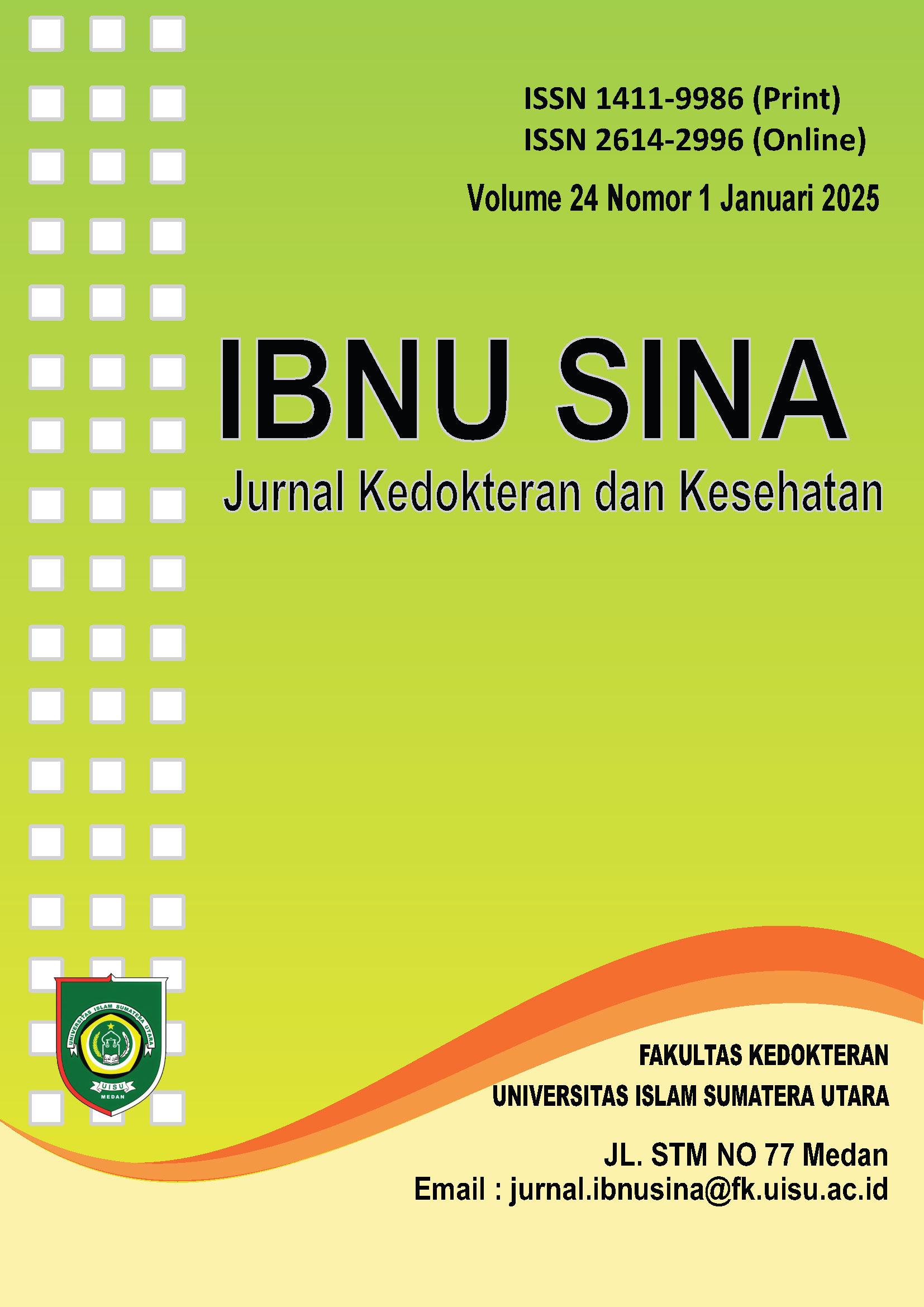ANALISIS TEKNOLOGI USIA TULANG MENGGUNAKAN KECERDASAN ARTIFISIAL: STUDI BIBLIOMETRIK
Abstract
Penentuan usia tulang (bone age) merupakan prosedur yang umum dilakukan dalam dunia kedokteran untuk mengevaluasi perkembangan tulang. Akan tetapi, prosedur ini umumnya dilakukan secara manual dan membutuhkan waktu yang lama untuk menilai dan menganalisis data. Oleh karena itu, diperlukan teknologi yang cepat dan akurat dalam menilai citra data untuk bone age. Teknologi kecerdasan artifisial atau artificial intelligence (AI) seperti deep learning dan machine learning dapat digunakan untuk mempercepat pembacaan hasil dengan akurasi yang tinggi. Oleh karena itu, pemodelan akan pembacaan bone age berbasis AI meningkat pesat dalam 10 tahun terakhir. Artikel ini bertujuan untuk menganalisis perkembangan penelitian terkait bone age berbasis AI di dunia hingga Juli 2024. Data diperoleh dari database Scopus, kemudian dianalisis menggunakan Excel dan VosViewer. Hasil yang diperoleh menggambarkan serangkaian penelitian sains di bidang bone age yang dirangkum dalam perkembangan publikasi ilmiah, sitasi dan penulis, serta kata kunci. Penelitian ini dapat membantu menganalisis kesenjangan pengetahuan sebagai peluang untuk kontribusi yang baru oleh berbagai peneliti di Dunia termasuk Indonesia. Studi ini memberikan gambaran informasi penting terkait perkembangan teknologi bone age menggunakan kecerdasan artifisial.
References
Prokop-Piotrkowska M, Marszałek-Dziuba K, Moszczyńska E, Szalecki M, Jurkiewicz E. Traditional and New Methods of Bone Age Assessment-An Overview. J Clin Res Pediatr Endocrinol. 2021;13(3):251. doi:10.4274/JCRPE.GALENOS.2020.2020.0091
Satoh M. Bone age: assessment methods and clinical applications. Clin Pediatr Endocrinol. 2015;24(4):143. doi:10.1297/CPE.24.143
Choi JA, Kim YC, Min SJ, Khil EK. A simple method for bone age assessment: The capitohamate planimetry. Eur Radiol. 2018;28(6):2299-2307. doi:10.1007/S00330-017-5255-4/FIGURES/6
Bajjad AA, Gupta S, Agarwal S, Pawar RA, Kothawade MU, Singh G. Use of artificial intelligence in determination of bone age of the healthy individuals: A scoping review. J World Fed Orthod. 2024;13(2):95-102. doi:10.1016/J.EJWF.2023.10.001
Gao C, Hu C, Qian Q, et al. Artificial intelligence model system for bone age assessment of preschool children. Pediatr Res 2024. Published online May 27, 2024:1-7. doi:10.1038/s41390-024-03282-5
Wang F, Gu X, Chen S, et al. Artificial intelligence system can achieve comparable results to experts for bone age assessment of Chinese children with abnormal growth and development. PeerJ. 2020;8:1-16. doi:10.7717/peerj.8854
Frank TD, Carter A, Jahagirdar D, et al. Global, regional, and national incidence, prevalence, and mortality of HIV, 1980-2017, and forecasts to 2030, for 195 countries and territories: A systematic analysis for the Global Burden of Diseases, Injuries, and Risk Factors Study 2017. Lancet HIV. 2019;6(12):e831-e859. doi:10.1016/S2352-3018(19)30196-1
Rosadi I, Karina K, Dewi PAS, et al. Stem cell research in Indonesia from 2003 to 2022: A bibliometrics analysis. J Pharm Pharmacogn Res. 2024;12(3):557-572. doi:10.56499/jppres23.1687_12.3.557
Larson DB, Chen MC, Lungren MP, Halabi SS, Stence N V., Langlotz CP. Performance of a Deep-Learning Neural Network Model in Assessing Skeletal Maturity on Pediatric Hand Radiographs. https://doi.org/101148/radiol2017170236. 2017;287(1):313-322. doi:10.1148/RADIOL.2017170236
Halabi SS, Prevedello LM, Kalpathy-Cramer J, et al. The RSNA Pediatric Bone Age Machine Learning Challenge. https://doi.org/101148/radiol2018180736. 2018;290(3):498-503. doi:10.1148/RADIOL.2018180736
Zhang A, Gertych A, Liu BJ. Automatic bone age assessment for young children from newborn to 7-year-old using carpal bones. Comput Med Imaging Graph. 2007;31(4-5):299-310. doi:10.1016/J.COMPMEDIMAG.2007.02.008
Kim JR, Shim WH, Yoon HM, et al. Computerized bone age estimation using deep learning-based program: Evaluation of the accuracy and efficiency. Am J Roentgenol. 2017;209(6):1374-1380. doi:10.2214/AJR.17.18224/ASSET/IMAGES/LARGE/12_17_18224_04.JPEG
Ren X, Li T, Yang X, et al. Regression Convolutional Neural Network for Automated Pediatric Bone Age Assessment from Hand Radiograph. IEEE J Biomed Heal Informatics. 2019;23(5):2030-2038. doi:10.1109/JBHI.2018.2876916
Mito T, Sato K, Mitani H. Cervical vertebral bone age in girls. Am J Orthod Dentofac Orthop. 2002;122(4):380-385. doi:10.1067/MOD.2002.126896
Mentzel HJ, Vilser C, Eulenstein M, et al. Assessment of skeletal age at the wrist in children with a new ultrasound device. Pediatr Radiol. 2005;35(4):429-433. doi:10.1007/S00247-004-1385-3/METRICS
Dallora AL, Anderberg P, Kvist O, Mendes E, Ruiz SD, Berglund JS. Bone age assessment with various machine learning techniques: A systematic literature review and meta-analysis. PLoS One. 2019;14(7):e0220242. doi:10.1371/JOURNAL.PONE.0220242
Zhao Q, Adeli E, Pohl KM. Training confounder-free deep learning models for medical applications. Nat Commun 2020 111. 2020;11(1):1-9. doi:10.1038/s41467-020-19784-9
Thodberg HH, Sävendahl L. Validation and Reference Values of Automated Bone Age Determination for Four Ethnicities. Acad Radiol. 2010;17(11):1425-1432. doi:10.1016/J.ACRA.2010.06.007
Wibisono A, Saputri MS, Mursanto P, et al. Deep Learning and Classic Machine Learning Approach for Automatic Bone Age Assessment. 2019 4th Asia-Pacific Conf Intell Robot Syst ACIRS 2019. Published online July 1, 2019:235-240. doi:10.1109/ACIRS.2019.8935965
Al Josan G, Nur Ichsan M, Sarwinda D, Bustamam A. Comparative Analysis of Bone Age Assessment Techniques Using Hand X-Ray Images and Gender Feature. 2022 5th Int Semin Res Inf Technol Intell Syst ISRITI 2022. Published online 2022:288-293. doi:10.1109/ISRITI56927.2022.10052941
Copyright (c) 2024 Sony Sutrisno

This work is licensed under a Creative Commons Attribution-ShareAlike 4.0 International License.



